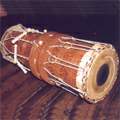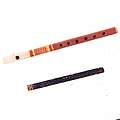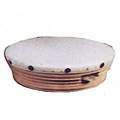The widespread development of music and dance in Sri Lanka has been greatly influenced and sustained by the production of high-quality musical instruments by the gifted craftspeople. The making of musical instruments is a traditional craft that has continued uninterrupted among certain communities; the requisite skills have been passed on from generation to generation.
DRUMS, TAMBOURINES, & PERCUSSION INSTRUMENTS
The ancient classification of the five-fold instrumental ensemble or pancaturya-bhanda consisted of a variety of drums (percussion), cymbals, flutes, and trumpets (wind and brass instruments). The Sri Lankan historical treatise Mahavamsa has recorded the existence of musical performances in ancient Sri Lanka. Music was studied seriously, with a lot of attention given to the codes and principles regulating its practice. In the mediaeval period, royal courts had specially appointed officials who supervised the performing arts: music, dancing, and singing. There are special references made to the performers using drums and trumpets (tamboru purampettukara) who performed in glorification of the king and also on ceremonial occasions.
Drums were – and still are – considered the most important component of Sri Lankan music. A wide variety of drums have been used for various purposes, ceremonial and otherwise; drums also had a special role to play in the battlefield. Drums were used frequently in religious occasions – the drum beats, it was felt, accorded auspiciousness and a sense of solemnity. Drums have also been associated with dance-forms; different types of drums were/are associated with each dance form.

1. TYPES OF DRUMS
There are several types of drums made for the professional drummers playing hevisi music; the critical ones are the davula from Sabaragamuwa province, the kettle drum, and the tammattamma (combined with the trumpet, horanava), all of which are played as an ensemble at Buddhist functions. The geta beraya or magul beraya is the typical Kandyan drum and the ruhunu beraya is its counterpart, played in the southern coastal areas; also known as the yak beraya, this is used during exorcising rituals.
There are other important drums, whose names indicate the presence of foreign influence(s); these drums are, however, well-integrated into local musical culture. The udekki – an hour-glass shaped drum used by the dancers who participate in the Perahera or the annual Kandyan pageant held in honour of the sacred Temple of the Tooth Relic -resembles a north Indian drum; the bummadiya – the pot drum made out of clay and iguana skin which is played at harvest festivals -is linked to the Dravidian pot drum; the rabana – a small tambourine-type drum used by dancing performers in a group in villages -is similar to the Malaysian rabana. The mrdanga, which is Indian in origin, is popular among local musicians and it is used in performances of the bharatanatya dance form. The maddala drum is, in all probability, south Indian in origin; it is used to play the rhythms for nadagam music. (Nadagam refers to the plays staged by troupes – either rural folk or urban theatre.)
2. RAW MATERIALS, CRAFT TECHNIQUES & PROCESSES
This craft requires a lot of skill and expertise: each instrument needs to function in a particular manner, and the craftspersons have to be extremely sensitive to creating the requisite sound and tone.
All the raw materials have to be treated, including the skins of animals used for the sides of the drums and the selections of tree trunks used. The types of wood used by the drum-makers are the jak or Artocarpus Integrifolia, the kitul or Caryota Urens, the mara or Albizzia Moluccana, the coconut or Coco Nucifera and, occasionally, the suriya or Thespesia Populnea. These varieties of wood are not difficult to obtain.
The crafting of most types of drums follows a fairly similar process and uses common techniques.

- GETA BERAYA: The geta beraya drum from Kandy is the most complex. It is made from a single undamaged block of wood; jak is the commonest, the other less common ones being the kohomba, (margosa – Azadirachta indica, vempu or neem tree) the ehela, (tiru konnal or konnai; bot name – Cassia fistula or Indian Laburnam), and the rat-handun (red sandalwood or Pterocarpus santalinus). The shell or bera kanda is scooped out to a thickness of no more than a quarter of an inch. The edge of one of the sides of this shell is rounded off, while the other is slightly turned out. In one place on each of these heads is a slight indenture – the anda-ira. For the two drum-heads two different types of vellums (thin filament like covers used to cover the drum-heads with) are used in order to produce two highly contrasted tones. The right side is usually made of monkey-skin and the left side of the tougher ox-skin. The drum-head has two pieces of leather with the top one extending over only a part of the head – about an inch or so around the head – and superimposed on the other which completely covers the eye. The vellum is kept in place by a circular ring known as the veni-vara-valalla, wound around the vellum at either end, eight times in all at regular intervals. The ends are then tied together. The desired tension on the drum-heads is obtained by tightening these braces. The length of the bera kanda is traditionally laid down as 27 inches, the drum-head is 8 inches in diameter, and the circumference of the drum at the centre is 25 inches. The drum is held at the waist of the drummer with a string – the urapota – the ends of which are tied to the loops at each end.
- YAK BERAYA: The yak beraya used in the southern part of the country is generally made in the same way out of kitul, using deer skin for the drum-heads.
- DAVULA: The davula from Sabaragamuwa province is cylindrical in shape and is also made out of jak; the drum heads are made out of either spotted deer skin or calf skin, held in place with braces called lanu made of Niyanda fibre (Sansivieria Zeylanica). Sliding rings called illam are inserted through the braces by means of which the drum-heads are tightened to obtain the required tension. The drum is given a lacquer polish and embellished with tassels hung on it. Unlike the geta beraya and the yak beraya, the davula is played with kaduppuwa (a striker used in playing the drums) made of atteriya or ratmal on one side and with the hand on the other.
- TAMMATAMMA: The tammatamma or the double drum is composed of two bayas in the shape of two large cups. The right hand drum is called the anda baya and has a drum-ad constructed like that of the geta beraya; it is set at a much higher pitch than the left one. This is beaten with both hands with two kaduppuwas made out of cane. As in the case of the geta beraya, the drum is suspended from the waist with a urapota.
- UDEKKI: The udekki is the drum with an hour-glass shape which is well-known in India. It is made of gansuriya (Thespesia populnea or puvarasu), ehela, and even jak wood, turned on a lathe. For making the drum-heads, the skin of the hare or the talagoya is used; this is kept in place by a detachable wooden ring called the valayan. This is controlled by the braces of niyanda passed through six holes on each ring. At the centre of the drum – over the braces – is a strap or patiya with which the drum is held by the drummer in his hand; the drummer can thus control the tension of the vellum by alternately pressing or loosening his grip on the strap. On the left hand is also placed the thatha or snare; this helps to increase the vibrations.
- DOLE: The dole is mainly made out of jak, beditel, or even coconut wood and it is fashioned in the same way as the geta beraya except that it is conical in shape. The larger drum head has a black spot known as badama. (The badama – which creates a thickness greater than on other parts of the drum-head – causes variations in the tone of the drum.) The vellum is made of either deer or calf skin and it is kept in place by braces and illam.
- RABANA: The single-faced rabana drum is made in varying sizes; the wood most frequently used to make it is the gansuriya. The vellum used also varies – ox skin is used for the larger instruments and monkey skin or hare skin for the smaller ones. The vellum is nailed to the top rim of the rabana. Rabanas used by the viridu players and by those who perform raban dances are embellished with brass studs along the side of the rim.

3. TOOLS & EQUIPMENT
The tools and equipment required to make the drums include a saw to cut the log to size, and a lathe to shape the outer structure and to scoop out the centre. Knives are required to cut the hides to shape.
4. PRACTITIONERS & CRAFT LOCATIONS
- A village by the name of Kuragala in Udunuwara in Kandy district has – over the past 50 years – grown into a flourishing drum-making centre. There are about 33 families here who are involved in this craft and over 200 artisans produce the drums required for schools besides providing for the special needs of temples and Kandyan dancers.
- Another village known as Kuragandeniya in Menikhinna situated very close to Kandy town is also a drum-making artisans’ settlement. There are about 15 families here involved in this craft. The artisans here face problems like a scarcity of raw materials, especially of deer, goat, rabbit, and iguana hides; they also face shortage of the right types of wood at times.
- Another group of drum-makers are from Weliganaga, Kotmale; they are displaced craftspersons, yet they have continued their craft without a break.
- There are various other groups of craftspeople who have organised themselves into units for making drums and other instruments. These groups are found in the districts of Kandy and Kegalle where certain traditional drum-makers reside whose descendants have taken to making certain special types of drums desired by the practitioners.
- Another group of craftsmen in Matara district in the southern part of the country have built for themselves a very solid reputation over the years for making and repairing drums and musical instruments. This group’s skills of craftsmanship are grounded in professional experience and they are also involved in making Indian-style dholaks and tablas for professionals.
5. INNOVATIONS
Toy drums are now in great demand in the handicrafts market. Most of these are miniature versions of the big drums like the udekki and rabana. These are used mainly by children for playing. There is great market-potential, both local and foreign, for the drums if the available resources are well-exploited to give a boost to the craft by expanding its production capacity.
WIND & STRING INSTRUMENTS
1. INSTRUMENTS
The critical role of wind and string instruments in music enriches has ensured that special attention has been paid by the craftspeople to this category of instruments also.
Flutes, trumpets, and horns are made locally to satisfy the needs of the local musicians. The flute – made of reed – is used by the rural folk of Sri Lanka. Flutes made for professional purposes are crafted by experienced craftspersons.
Other stringed instruments made by the craftspeople include violins (of the Western kind), sitars, and esrajs, (from the southern part of India; mainly used in Indian classical music). Guitars, mandolins, pianos, banjos, and dilrubas (a north-Indian instrument) are made. Some combined instruments – innovative pieces that produce the music of more than one type of instrument when played – are also being made.
For many years such instruments were imported into the country; however local artisans have acquired expertise in the craft. There are many craftspeople who have made a mark in making such instruments in Sri Lanka over the years. Initially these craftspeople began making simple instruments; later on they adopted newer and more sophisticated techniques.
2. RAW MATERIALS
All the materials that are essential for the making of such instruments are available locally. Some of the wood-types for making instruments in this category are halmilla, tuna, nedun (Pericopsis Moomana or a type of hard-wood), and ebony.
3. INTERVENTIONS
The Department of Small Industries of the Government of Sri Lanka have had a successful violin-making project at Moratuwa in Colombo district where the processed maple and pinewood pieces are supplied from Italy regularly. The artisans who form a part of the project are involved in planing, shaping, designing, and assembling the parts. Both the classical types of violins are made – the Stradivarius and the Guarnerius. These violins also have locally made ebony fingerboards with some intricate carving done on them. As the last stage in the process, these pieces are then polished.
Gallery
YOUR VIEWS
PRACTITIONERS: INDIA
Access 70,000+ practitioners in 2500+ crafts across India.
BIBLIOGRAPHY
10,000+ listings on arts, crafts, design, heritage, culture etc.
GLOSSARY
Rich and often unfamiliar vocabulary of crafts and textiles.
SHOP at India InCH
Needs to be written.






